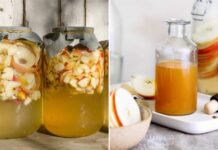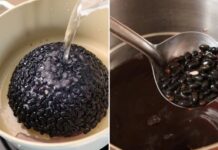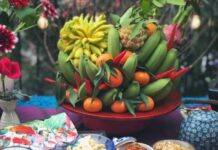Plum trees thrive in the provinces of Son La, Moc Chau, Lang Son, Lao Cai, Ha Giang, Cao Bang, and Dien Bien, among others. The flavor of these plums is greatly influenced not only by the variety and age of the trees but also by the unique soil composition of each region.
Popular Plum Varieties in the Market
There are numerous types of plums, and the following are the most popular and favored varieties currently available in Vietnam.
Son La Ruby Plum

Son La Ruby Plums are large and uniform in size, ranging from 18-25 plums per kilogram. (Photo: Tasting Table)
The Son La Ruby Plum, also known as the plum king, is cultivated in the Nà Ka valley of Moc Chau, Son La. These plums are exceptionally sweet, with round, large fruit. Each kilogram typically yields only 18-25 plums. The skin of these plums boasts a beautiful blend of ruby red and green hues, with a characteristic white powdery coating. As they ripen, they take on a deep red color reminiscent of cherries.
The Son La Ruby Plums undergo meticulous care and selection. Out of every 100 plums grown in Son La, only five meet the stringent standards for this premium variety. The trees selected for this variety are carefully chosen from ancient plum trees spaced far apart to allow for ample sunlight and air circulation. To ensure the highest quality fruit, farmers meticulously thin the crop, removing 30%-50% of the plums, as well as carefully pruning the branches and leaving only the most promising fruit at the end of each branch. Grown at an elevation of 1,500 meters above sea level in the Nà Ka valley, these plums benefit from significant day-to-night temperature variations, resulting in a richer, sweeter flavor compared to plums from other regions.
Pu Nhi Plum

Pu Nhi Plum, a specialty of Son La province, is often likened to “Vietnamese Cherry.” (Photo: Cleanipedia)
The Pu Nhi Plum is a specialty fruit of Son La, earning the nickname “Vietnamese Cherry.” It is cultivated in the Pu Nhi mountains of Song Ma district, Son La province. This indigenous plum variety is prevalent in several villages of Moc Chau and Song Ma.
The Pu Nhi plum trees are long-lived, and the fruit quality can vary depending on the climate and soil conditions. The high mountains and dry, golden soil of this region result in slow-growing trees that bear small, sparse fruit. The local ethnic community in Pu Nhi continues to practice traditional farming methods, allowing the trees to grow, flower, and fruit naturally, relying on the whims of the weather.
The unique combination of high-altitude cultivation, favorable soil, and the distinct climate of Northwest Vietnam results in plums that, while smaller than those from other regions, boast a deep red color, a crisp texture, and a thin skin. These plums are covered in a beautiful white powder and, when ripe, offer an explosion of sweetness with a delightful aftertaste. The trees are long-lived, and the fruit is of exceptional quality.
The harvesting season for Pu Nhi Plums is extremely short, lasting only 20 days, and they are not available year-round, making this specialty fruit a rare treat compared to more common plum varieties.
Tam Hoa Plum

Tam Hoa Plums ripen to a vibrant red, offering a crisp texture and a mild sweetness with a characteristic hint of astringency, without any bitterness. (Photo: Southern Living)
Among the various plum varieties in the market, the Tam Hoa plum is more widely sold than the previous two types. This specialty of Bac Ha, Lao Cai, is also found in Ha Giang and Cao Bang provinces.
Tam Hoa plums are known for their large, round, and visually appealing fruit. When ripe, they boast a vibrant red color, ranging from bright to deep red. They have a thick layer of flesh and small seeds. The fruit is crisp and sweet, with a mildly astringent skin that is not bitter. Slightly unripe Tam Hoa plums have a pleasant sour taste and are delicious when dipped in salt.
Lao Cai and Son La provinces are significant producers of Tam Hoa plums, with ideal growing conditions found at elevations above 800 meters, where the climate is cool and breezy.
King Plum

King Plum is a specialty of Son La province, renowned for its delicious flavor. (Photo: coedo.com)
The King Plum, or Mận hậu, is a popular variety in the market and a delicacy of the Northwest mountainous region. While it is grown in various areas, the most renowned King Plums originate from Son La province, where the natural conditions impart a distinctive and delectable flavor to the fruit.
The King Plum is characterized by its large size, firm and thick flesh, and small seeds. When unripe, these plums are quite sour and astringent, with taut, shiny skin. As they ripen, they transform into a deep red color reminiscent of cherries, with crisp, sweet flesh. Their skin is marked by a white powdery coating.
Rice Plum

Rice Plum, also known as Thóc Plum, comes in various colors, including red, yellow, and green. (Photo: bTaske)
The Rice Plum, also called the Thóc Plum, is grown mainly in the midland and mountainous areas of northern Vietnam. It has a unique flavor profile, starting with a sour and astringent taste that gradually gives way to sweetness.
Rice Plums are small, with green skin that turns yellow and pale red as they ripen. They have a crisp texture, a mild sourness, and small, easily removable seeds. For those who enjoy sour flavors, Rice Plums tossed with salty chili or sour plum sauce are a delightful treat.
Ta Van Plum

Ta Van Plums ripen to a vibrant red, with a matching red flesh. (Photo: Instacart)
The Ta Van Plum is a unique variety grown in the highland communes of Bac Ha and Si Ma Cai districts in Lao Cai province, with the largest production in Ta Van Chu commune, Bac Ha district.
This variety is quite particular about its growing conditions and only achieves optimal sweetness and crispness when cultivated at elevations above 1,500 meters. This factor likely contributes to the distinctive flavor of Ta Van Plums.
When ripe, Ta Van Plums exhibit a vibrant red color, both on the outside and inside. They are fragrant, crisp, and offer a delightful combination of natural sweetness and mild sourness. In addition to being consumed fresh, Ta Van Plums are used by locals to create delectable and nutritious treats such as plum jam, syrup, juice, plum dips, and even plum yogurt.
According to VTC News


































